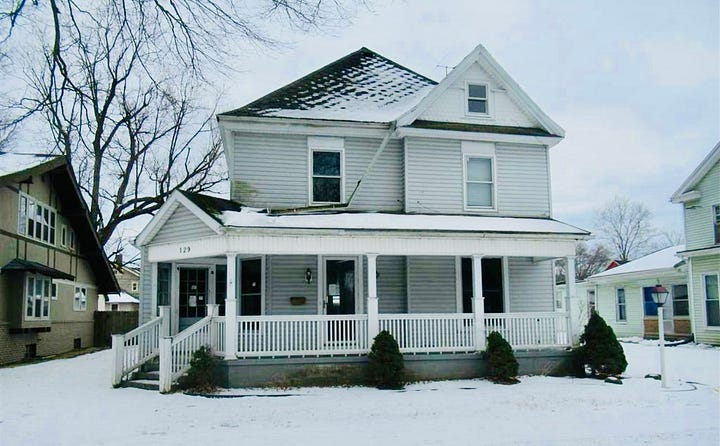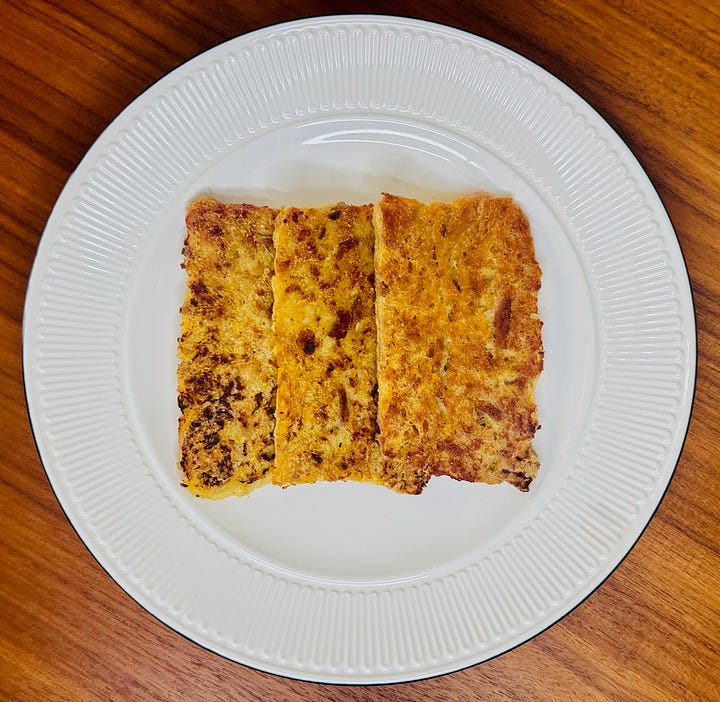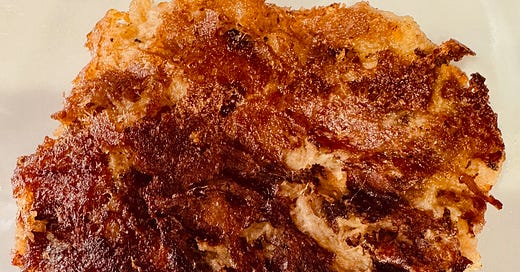Five-Generation Pan Haus. Ahem! What?
From 1820s Pennsylvania to modern kitchens, our German-American family's cherished breakfast tradition with shopping list and modern twists
This Sunday, I’m sharing our cherished five-generation family recipe for Pan Haus, a Pennsylvania Dutch dish, also known as Scrapple. Along with the full recipe and shopping list, I’ll explore how it became woven into our family traditions, share a Pennsylvania Dutch dictionary, recommend a documentary, and offer some modern twists on this classic comfort food.
Pan Haus
Pan Haus is a savory dish made with pork, cornmeal, salt, and pepper. Also referred to as Scrapple, the dish can be made with wheat flour instead of cornmeal. Over time, various regional recipes have evolved, incorporating different ingredients and seasonings like sage, herbs and spices, onions - even beef broth. The name of the dish is German, but the dish itself may have been influenced by Welsh rabbit.
Widely considered a traditional Pennsylvania Dutch dish, its roots trace back to German immigrants who settled in Pennsylvania. “Dutch” is actually a mispronunciation of “Deutsch” (German). As they moved westward, this dish found its way into many family traditions.
Typically fried and enjoyed with eggs and bacon, it’s become our family Christmas breakfast tradition.
For more interesting insights, check out this Pennsylvania Dutch Dictionary or watch this documentary Tastes of Evansville: Pon Haus, produced by Feel the History class at F.J. Reitz High School in Evansville, Indiana.
Pull up a chair! Upgrade now to unlock the recipes, the stories, and our special holiday pricing: 25% off annual subscriptions 🎄 Just $64/year!
Five Generations of Tradition
Pan Haus, a dish made with humble ingredients, has become a symbol of our family’s history, a recipe passed down from mother to daughter, father to son, shaping the heart of family gatherings for generations.
1820s: The Beginning of a Legacy
Mary Kantner, 3rd great-grandmother, was born in Lancaster, Pennsylvania. She married Joseph Gehring, a man from Baden-Württemberg, Germany (then Prussia), and together, drawn by the promise of farmland, settled in Germantown, Indiana. It’s thought that Joseph and Mary, a Pennsylvania Dutch family, brought this recipe to Indiana. Little did they know, this humble dish would become a treasured family tradition for generations to come.
1860s: A New Generation
Mary’s daughter, Alice Gehring, married Augustus Weidman, also from German descent, and they continued their lives in Indiana. The dish was passed down, evolving over time as the Weidman family likely put their own spin on it, adapting it to the ever-changing flavors of the new world.


1900s: The Tradition Grows
Alice’s daughter, Clara Weidman, married Jesse Baker, and made their home in Hagerstown, Indiana. It was there that the tradition of Pan Haus became firmly rooted. My grandmother, Clara, and her family continued to make this dish a part of their winter season. My grandfather, John Baker, married Mary Jane Carnes, and their home carried the torch of this family tradition.
1940s and Beyond: Generations Carry the Flame
For over 60 years, the Carnes/Baker tribe kept the tradition alive. My mom, her siblings, and cousins, along with the larger extended family, enjoyed countless meals together. Each time the dish was made, it served as a reminder of the generations before them and the stories embedded in every bite.
Today, the tradition lives on in the Blair/Baker/Carnes/Nelson/Blanke tribes, as it is handed down with love to the next generation. But will they carry it forward? Times have changed, and family traditions evolve, but the recipe is safely archived here, holding space for future generations to find.
For over five generations, this “odd” dish, which seems simple, but packs a punch, especially for those who love bacon, has endured.


Recipe Revival: Our Family’s Pan Haus Recipe
Makes 5 tins of German-Pennsylvania Dutch-Midwest goodness
Ingredients
6 pounds pork tenderloin
Water (enough to cover the meat) plus 4 cups
1 tablespoon kosher salt
1/2 tablespoon black pepper
8 Wyler’s chicken bouillon cubes
1 tablespoon roasted chicken Better Than Bouillon
32 ounces chicken broth
4 cups cornmeal
Method
Place the pork loin in a large pot. Add the kosher salt, black pepper, 4 bouillon cubes, Better Than Bouillon, and chicken broth. Fill the pot with water until the pork is just covered. Cover with the lid.
Bring the mixture to a boil, which will take about 20-30 minutes. Once it reaches a boil, cover with the lid, reduce the heat, and let it simmer for approximately 2-3 hours, or until it becomes tender and easily pulls apart.
Remove the pork from the pot and set it aside to cool.
Transfer the broth to the refrigerator and let it cool for 2 hours, or overnight.
Once the pork has cooled, shred it. If you don’t have time, refrigerate the pork overnight. The next morning, allow it to come to room temperature before shredding. The shredding process should take about 30 minutes.
Remove the broth from the refrigerator and skim off the fat that has solidified on the top.
The following day, bring the broth to a boil. While it’s warming, mix the water with the cornmeal using a whisk.
Pour the cornmeal mixture into the pot, then add the pork, and 4 bouillon cubes to the pot and stir. Once the broth boils, reduce to a simmer.
Simmer for 2-3 hours, stirring every 30 minutes to prevent the meal from sticking to the bottom of the pan and burning. Some sticking is normal, so don’t worry too much. The goal is to cook until the mixture firms up to a consistency that’s neither too firm nor too loose - just right.
Ladle the mixture into the aluminum pans then wrap in aluminum foil.
Store one container in the fridge and the rest in the freezer until you’re ready to use them or gift them to friends and family.
When you’re ready to fry, remove a tin of pan haus from the freezer and let it defrost in the fridge overnight.
The next morning, pop the pan haus out of the tin onto a cutting board, then slice it into 1/4-inch-thick pieces.
Place the slices on paper towels to absorb excess moisture.
Heat a large cast iron skillet over medium-high heat.
Add bacon grease, butter, or lard to the skillet and let it melt before adding the slices.
Let the slices brown completely on one side before flipping, about 3 minutes per side. Patience is key - if you flip them too soon, they may stick or fall apart.
Serve for breakfast with eggs and bacon.
Shopping List
shredding claws or 2 Forks
Modern Twist: Tips to Adapt to Your Schedule, Healthy Swaps, and Plant-Based Options
Tips
Split the work over two days for a more manageable process.
Halve the recipe to lighten the workload.
Cook the cornmeal, pork, and broth in under 30 minutes for a quicker meal.
Swaps
Pork → Seitan
Kosher salt → Coarse sea salt
Bouillon cubes → Chicken broth
Better Than Bouillon → Chicken broth
Chicken broth → Vegetable broth
Cornmeal → Polenta
Lard or bacon grease → Vegetable shortening
Options
Vrapple, made with Seitan
Icicle Pickle Update
It’s Day 11 of the Icicle Pickle Brining Project. They’re still a bit tangy, but the California version is, in my opinion, tastier than the original. I’ll give them another 4 days before making a final decision on the recipe. I’ll post an update in Chat on Thursday Dec 19.
Leave a comment, show your love, or spread the joy with a gift subscription!









One of my favorites! Love learning more of the history of this delicious food!
This was a great memory for me I have been eating pan haus since I was a little girl and now an old woman of 82 I still enjoy it very much Not just the wonderful taste but the memories that come to me. Many times we would have it Christmas or holidays and family stories would be remembered as we would sit and enjoy this with eggs and bacon
It is a family tradition and I hope others will see it as a special family food carried down the generations